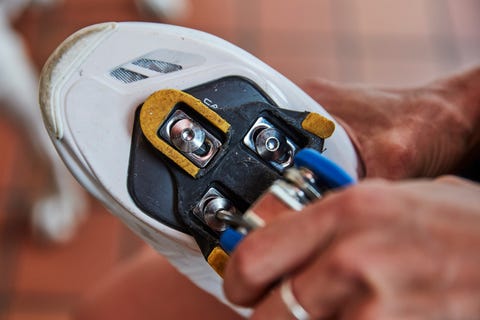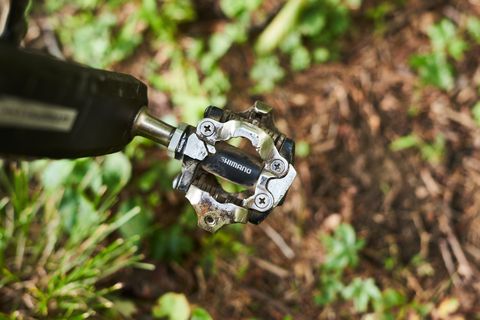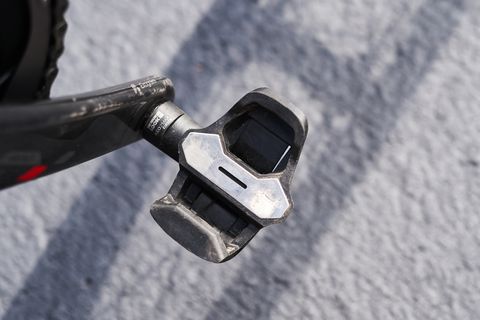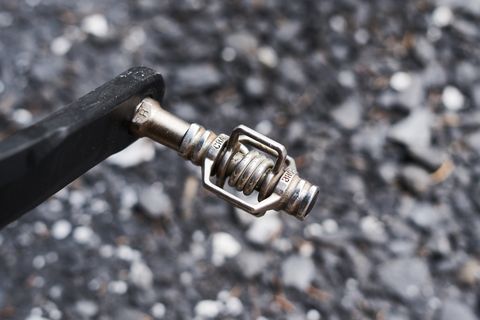How to Install Look Cleats on Bike Shoes
We know clipless pedals seem counterintuitive—don't you actually clip your shoe into those pedals? Yes, you do. But the term "clipless" came about to differentiate this type of pedal from the commonly used pedal of the past that featured a "toe-clip" (or cage) to secure your foot. So the word "clipless" refers to the lack of a toe-clip; it's also different from the flat pedal style, which is technically clipless but doesn't use any attachment system.
Though clipping in might seem strange at first (and yes, you do fall over on occasion, especially while learning), using clipless pedals comes with benefits like better pedaling efficiency, power transfer, and overall bike control.
If you've made your way to this page, you're ready to take the next step in cycling and upgrade to clipless pedals. Here's how to install clipless pedals and a brief guide to the most common types available.
How to Remove and Install Pedals
First, you'll need to remove your old pedals by using either a pedal wrench or the correct size Allen key (a.k.a. hex wrench, most take 6mm or 8mm). A pedal wrench or Allen key will fit into the end of the pedal's spindle on the inside of the crank arm.
The old adage "righty tighty, lefty loosey" is only true for the right-side pedal (when viewing from the outside of the pedal)—it's the opposite for the left pedal. Another way to think of it: The threading on the pedals is designed to tighten in the direction that you pedal, to prevent the pedals from unscrewing as you ride. An easy way to remember this when removing pedals is by thinking, "pedal forward, rotate backward." By using the tool to spin both the right and left pedals toward the rear wheel, you'll successfully remove the old pedals.
How easy it is to remove your pedals depends on how they were installed. (Was there grease added? Were they secured very tight?). If you're using an Allen key or a multi-tool, you may find you can't get enough leverage to loosen the pedal. That's when a pedal wrench really comes in handy.
You'll want to keep the removal in mind when you install your new clipless pedals: Grease the threads to prevent them from getting stuck over time—you'll want to be able to remove them eventually. Insert the pedal spindle into the crank arm and align with the threading. Insert the Allen key into the end of the pedal spindle or place the pedal wrench onto the spindle and rotate toward the front wheel on both the left and right pedals.
[Want to fly up hills? Climb! gives you the workouts and mental strategies to conquer your nearest peak.]
Installing the Cleats
You'll need the right pair of cycling shoes, either 2- or 3-bolt compatible, to go with the clipless pedal system you select. (See more info on those systems below.) All clipless systems function similarly: You mount the cleats to the bottom of your shoes, and the cleats engage with the pedals.

Trevor Raab
To install the cleat onto your shoe, determine exactly where to place it. All clipless systems give a generous range of placement from front to back, and a smaller range side to side, near the toe of the shoe. A good general rule of thumb is to have the horizontal middle of the cleat line up with the ball of your foot. (You should refer to the manufacturer's instructions, too.)
Adjusting cleat placement from there can depend on personal preference, comfort, and biomechanics. Ideally, you should get a professional bike fit done since improper cleat placement can lead to discomfort or chronic issues.
Clipless systems usually offer a range of "float" between the cleat and the pedal when engaged—this is the degree of play, or movement, that your foot can rotate from side to side when clipped in. A clipless system with more float tends to be better for beginner cyclists, because it's easier to release your foot from the pedal, and those with joint issues. A pedal-cleat setup with more float also lends a little more room for error with cleat placement.
Alternatively, some systems come with zero float, which is harder to disengage but offers better power transfer and pedaling efficiency, so it's often preferred by more advanced riders and competitive cyclists. Your cleat placement with a no-float setup should be as precise as possible.
When installing, be sure to grease the bolts that secure the cleat to the shoe to prevent them from rusting and to allow you to move them if necessary. Once you find the right cleat placement, you can trace the outside of the cleat onto the sole of the shoe with a permanent marker so you can always replace the cleat in the exact same spot each time. (You'll replace your cleat many times but rarely your pedals as the cleats get worn down when walking.)
Types of Clipless Pedals and Cleats
The main difference between clipless systems is the cleat/pedal style and how the cleat integrates with the pedal. Here are some of the most popular styles of clipless pedals, along with brief explanations of what they entail to help inform your purchase.
Shimano SPD

Trevor Raab
Shimano boasts that it hasn't changed this clipless style since the company first created it in 1990, because why mess with a good thing? SPD is the standard clipless system for mountain bikes—it's easy to use, durable, and withstands dirt buildup better than road pedals. SPD cleats use two bolts to attach to the shoe. SPD pedals are usually two sided, which means you can clip in on either side, though you can find hybrid pedals that are flat on one side, which are a great option for commuter bikes.
SPD cleats inherently have a fair amount of float, but what you can adjust is the amount of spring tension in the pedal. Unlike road bike cleats, SPD cleats are smaller and sit in a recessed area on the bottom of the shoe, which makes it much easier to walk in once off the bike, and this also makes them popular among gravel riders, cyclocross racers, and adventure cyclists who often dismount their bikes.
Shimano also offers a beginner-friendly clipless system called CLICK'R. It's similar to the SPD style, but takes a lot less effort to get in and out of the pedals.
Shimano SPD-SL

Trevor Raab
SPD-SL cleats use three bolts to mount to the shoe. The cleat is much bigger than the basic SPD cleat above. These cleats can make it tricky to walk around on—plus walking will wear down the cleat much faster—but they offer a wide platform for power transfer and stability on the bike. Shimano has three cleats to pick from, each with a different level of float: 0, 2, or 6 degrees. You'll find these clipless pedals on road, track, and triathlon bikes.
Look

Trevor Raab
Another popular option for road and track cycling is Look's clipless system. Look's cleats also use three bolts to attach to the shoe, similar to SPD-SL. In fact, it was Look that first popularized this style of clipless pedal in the 80s. The cleats come in three different degrees of float: 0, 4.5, and 9. A nice feature with Look's cleats is that they come with a "memory positioner" to make replacing them easier. This style of pedal is often used on indoor cycling bikes at indoor cycling studios and gyms.
Crankbrothers

Trevor Raab
One SPD-alternative for mountain bikers and other off-road cyclists is the clipless system from Crankbrothers. The company offers everything from a super-minimalist "egg-beater" style of pedal, to a wide-platform, DH pedal. There are four cleats to choose from, according to the amount of float and release angle. Crankbrothers also makes a kind of cleat with an adapter for 3-bolt road shoes that allows you to use their 2-bolt style pedals.
Speedplay

matt phillips
The clipless pedals from Wahoo Speedplay are a unique option that look, and work, dramatically different from both the SPD and SPD-SL styles. These pedals are easily recognizable by their small, round shape. Wahoo Speedplay only offers clipless pedals for road cycling shoes at the moment. (Speedplay previously offered the off-road friendly, two-bolt compatible Frog and SYZR clipless systems.) The road bike cleats come with adapters, so they can be mounted to 3-bolt style shoes.
Jessica Coulon Assistant Digital Editor When she's not out riding her mountain bike, Jessica reports on news, gear, and all things cycling related for Bicycling.
This content is created and maintained by a third party, and imported onto this page to help users provide their email addresses. You may be able to find more information about this and similar content at piano.io
How to Install Look Cleats on Bike Shoes
Source: https://www.bicycling.com/skills-tips/a33402788/how-to-install-clipless-pedals/